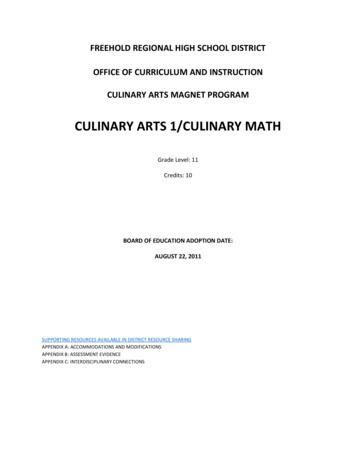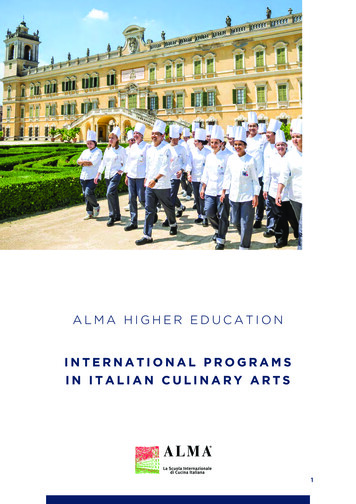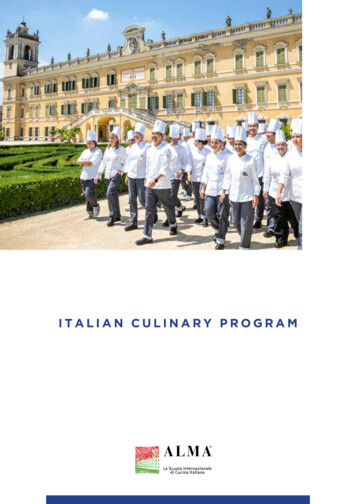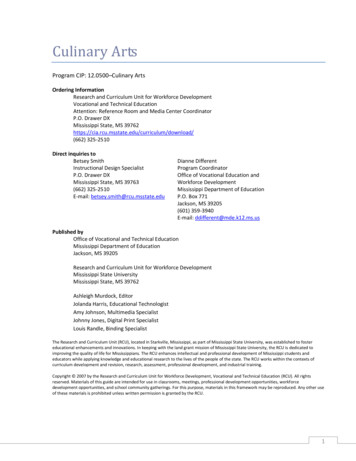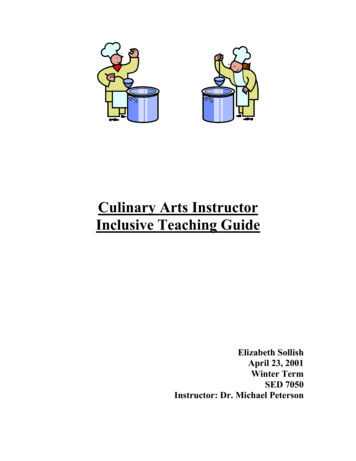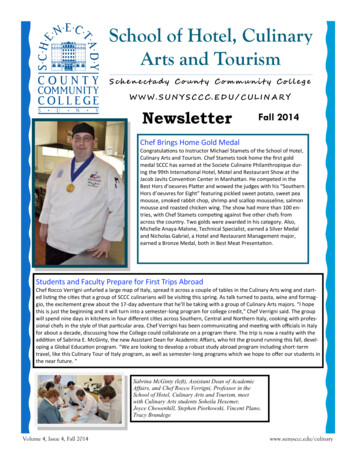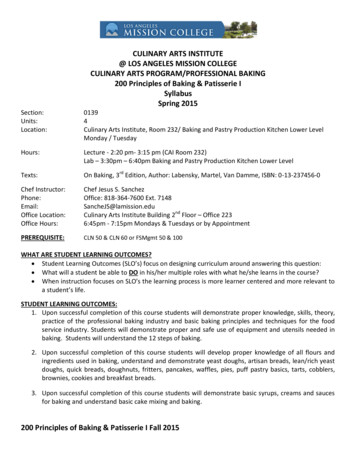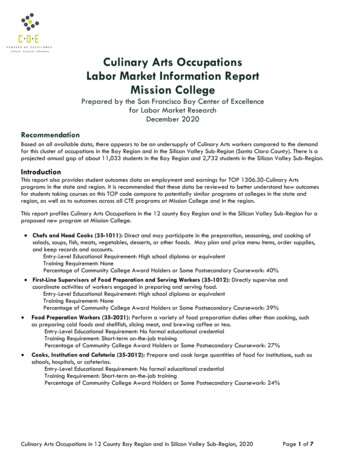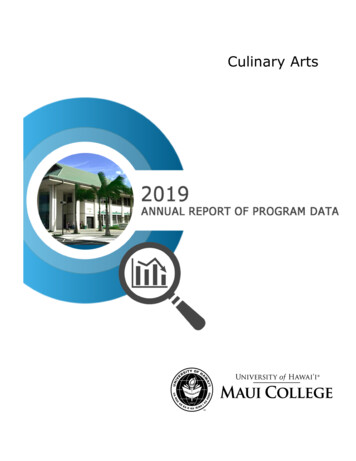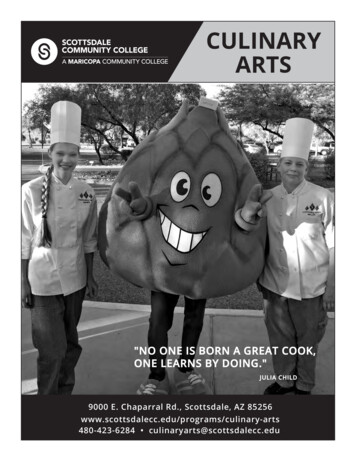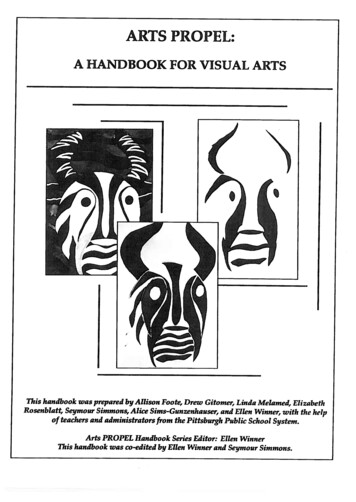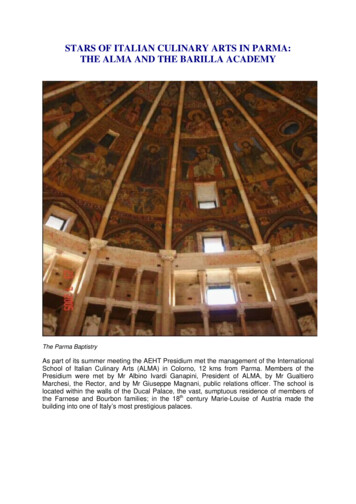
Transcription
STARS OF ITALIAN CULINARY ARTS IN PARMA:THE ALMA AND THE BARILLA ACADEMYThe Parma BaptistryAs part of its summer meeting the AEHT Presidium met the management of the InternationalSchool of Italian Culinary Arts (ALMA) in Colorno, 12 kms from Parma. Members of thePresidium were met by Mr Albino Ivardi Ganapini, President of ALMA, by Mr GualtieroMarchesi, the Rector, and by Mr Giuseppe Magnani, public relations officer. The school islocated within the walls of the Ducal Palace, the vast, sumptuous residence of members ofthe Farnese and Bourbon families; in the 18th century Marie-Louise of Austria made thebuilding into one of Italy’s most prestigious palaces.
The School was founded in 2004, and from the start enjoyed the support and collaboration ofthe famous chef, Gualtiero Marchesi, the first Italian to be awarded three Michelin stars.Each year the ALMA takes in two groups of 40 candidates for a total of 11 weeks, dividedbetween theory classes (30%), practical sessions (70%) held in the school, and 20 weeks ofpractical placements in Italy’s finest restaurants. On completion of the course the diplomatesare awarded the title of ‘Maestro di Cucina Italiana’ – ‘Master of Italian Culinary Arts’. Theteaching staff consists of around 40 of the best chefs and pastry cooks from all regions ofItaly. Mr Marchesi emphasised that there is no such thing as a single Italian culinary art, buta multitude of regional cuisines characterised by microclimates and very specific localgrowing conditions.The Colorno Ducal Palace is home to the International School of Italian Culinary Arts (ALMA)As well as its higher education programmes, the ALMA offers courses enabling professionalchefs to perfect their knowledge and skills in the areas of pastry, fish, etc. As ambassador ofItalian culinary heritage, the ALMA arranges (either on its own premises or abroad) tailormade training courses or programmes, for example for hotel chains or for hotel schoolsthroughout the world. (China, Taiwan, Japan, USA, Canada, etc.).The AEHT plans to collaborate closely with the ALMA to enable its member schools to takeadvantage of this professional training opportunity which is unique in Italy.After an exquisite meal prepared by ALMA students and eaten in the company of ahospitable and enthusiastic ‘Maestro’ Marchesi, the Presidium set off for the AcademiaBarilla in Parma, a town which has for a long time been recognised as the capital of Italianculinary arts. Parma was recently elected European Capital of Gastronomy, and has beenselected to host the European Authority for Food Safety (a body created by the EuropeanCommunity in December 2003 with inspection and certification powers for the various
phases of food production); Parma is the location of the head office of the famous Barillabrand of foods, and has hosted the Barilla Academy for the last 18 months. The Academy isthe first international centre for the promotion of Italian culinary arts, and has set as itsobjectives the development and promotion of Italian gastronomic tradition – true Italiancuisine - beyond the borders of Italy itself. The services of the Academy are aimed atprofessionals as well as at food-lovers, and include Italian specialities and a range of cookerycourses.The demonstration kitchen in the Academia Barilla lecture theatre.Three librarians worked for over a year to assemble one of Italy’s most remarkable collectionof books on gastronomy. Today the Academia Barilla’s gastronomy library contains morethan 7,000 tomes, including editions which are unique in the whole world. A magnificent 16thcentury work, one of the collection’s oldest books, is the pride and joy of Mr Gianluigi Zenti,Director of Administration.
Mr Zenti shows visitors a collection of articles on ‘La Cucina Italiana' dating from December 1929.Mr Lucien Ducrey, assistant to Mr Zenti, guided the Presidium through the training kitchens,tasting rooms, pastry and pizza laboratories. All the installations are brand new andrepresent the very latest technology. More than 1,800 people have already taken courses atthe academy, and more than 5,000 people have visited the premises, among them 50-60%foreigners.Hans Russegger, Neeme Rand, Lucien Ducrey and Adolf F. Steindl during the visit of the AcademiaBarilla premises
Between September 14th and 16th the European olive oil industry will come together at thecentre for a three day international workshop entitled ‘The Present and the Future ofEuropean Olive Oil’; the event is co-financed by the European Union and aims to promotethe use of olive oil in European countries, especially those which consume little olive oil, andthe new EU member countries.While enjoying their drinks the Presidium members had the chance to discuss with theAcademy’s officers the possibilities of collaboration over the organisation of seminars. TheAEHT hopes that shortly this Academy as well as the International School of Italian CulinaryArts (ALMA) will become members of the Association.For the remainder of the afternoon and the following morning the Presidium held its meetingto discuss the AEHT’s current issues. The agenda was long, and six hours were required tocover all the items. The decisions taken will be presented during the Antalya AnnualConference.The Parma Rotta restaurant in Parma
In the evening the Presidium were the guests of Barilla at the Parma Rotta restaurant (ViaLanghirano 158, 43100 Parma, not far from the place where the River Parma most frequentlyexperiences flooding); they had the opportunity to taste typical dishes from the Parma regionprepared by the chef Antonio di Vita: Parmesan cheese, Parma ham, Culatello di Zibello,Felino salami, black mushrooms and truffles from the region are only a few of the highlightsof the delicious range of products which are characteristic of an undeniably high-qualitygastronomy which members of the Presidium could savour.Antonio Di Vita Surrounded by Members of the PresidiumSaturday afternoon was set aside for a guided tour of Parma, a resplendent town boastingseveral exceptional buildings. Parma is of Etruscan origin, then became a flourishing Romancolony. In the Middle Ages Parma suffered many battles and invasions on account of itswealth and its strategic position.
The Cathedral and the BaptisteryMagnificent examples of Romanesque art such as the Cathedral (dating from 1106, and atpresent undergoing restoration in preparation for its 900th anniversary which it will shortly becelebrating) and the Baptistery (13th century) are both witnesses to a glorious past. Otherbuildings are also ‘worth a detour’ as Michelin says: the renaissance St John the Evangelistchurch, embellished with frescos by Antonio Allegri (also known as Correggio); the baroque‘la Steccata’ church of the Virgin, whose interior shows the genius of Francesco Mazzola(also known as Parmigianino). Parma became independent under the government of theDukes of Farnese (1545 – 1731), and acquired other artistic and architectural masterpieces,thus creating an itinerary filled with charm and magic among the streets of the historic towncentre. Don’t miss it!Fresco by CorreggioFresco by the young Parmigianino
School of Italian Culinary Arts (ALMA) in Colorno, 12 kms from Parma. Members of the Presidium were met by Mr Albino Ivardi Ganapini, President of ALMA, by Mr Gualtiero Marchesi, the Rector, and by Mr Giuseppe Magnani, public relations officer. The school is located within the walls of the
